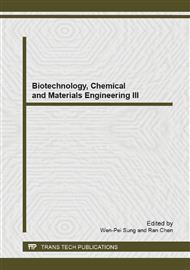p.389
p.394
p.401
p.405
p.409
p.415
p.419
p.423
p.429
Comparison of the Effect of Sterilization Pretreatment Using Four Different Bacteriostatic Agents on the Quality of Penaeus vannamei
Abstract:
Four different bacteriostatic agents H2O2, NaClO, ClO2, and ozone water (O3) were used to the sterilization pretreatment of fresh muscle of penaeus vannamei. The bactericidal effect of these bacteriostatic agents were evaluated by aerobic bacterial count method, sensory evaluation and chromatic aberration analysis. The results showed that the optimum pretreatment concentrations of sterilization pretreatment by H2O2, NaClO, ClO2 and ozone water (O3) were 3.0 g/kg, 50 mg/kg, 150 mg/kg and 1.0 mg/kg respectively. The optimum pretreatment time of sterilization pretreatment by H2O2, NaClO, ClO2 and ozone water (O3) were 60 s, 300 s, 300 s and 300 s respectively. Furthermore, the bactericidal coefficients of sterilization pretreatment by H2O2, NaClO, ClO2 and ozone water (O3) were 91.6%, 95.1%, 92.3% and 99.6% respectively. The effects of color and flavor of fresh muscle treated by these four bacteriostatic agents were compared. The results showed that the color and flavor of fresh muscle was less effected by ozone water (O3) method used for sterilization pretreatment method than other three methods. The total number of bacterial colony of sample treated 600 s by 1.0 mg/kg of ozone water (O3) method was reduced to 3.4 lgCFU/g, and the advantages of this method are significant sterilization effect as well as the low influences of color and sensory quality.
Info:
Periodical:
Pages:
409-414
Citation:
Online since:
January 2014
Authors:
Keywords:
Price:
Сopyright:
© 2014 Trans Tech Publications Ltd. All Rights Reserved
Share:
Citation:


